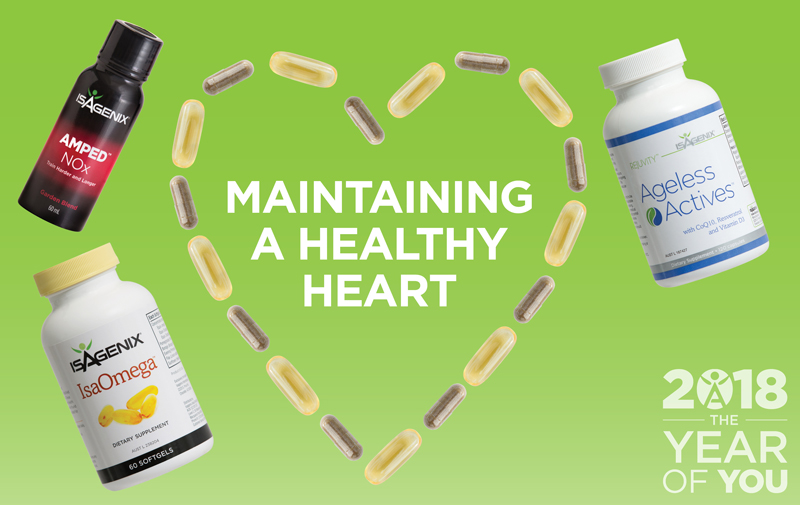With February being all about celebrating the power of our most hard-working organ – the heart, now’s the perfect opportunity to discuss one of the most important heart-healthy nutrients in your dietary arsenal: the long-chain, omega-3 fatty acids eicosapentaenoic acid (EPA) and docosahexaenoic acid (DHA) from fish.
In addition to EPA and DHA, omega-3 fatty acids also include alpha-linolenic acid (ALA), which is present in some vegetable oils, nuts, seeds and green leafy vegetables. Although ALA is the natural precursor to the longer-chain EPA and DHA, this conversion is slow and inefficient in humans. For this reason, The Australian Heart Foundation, along with most health experts, recommend increasing dietary intake of EPA and DHA from oily fish, or from high-quality dietary supplements such as IsaOmega™ (1).
Fish with the highest levels of omega-3 include salmon, blue-eye trevalla, blue mackerel, herring, canned sardines, canned salmon and some varieties of canned tuna. Other good sources of marine-sourced omega-3s include barramundi, bream, flathead, squid, scallops and mussels.
We know there are heart-health benefits from a diet rich in omega-3 fatty acids but few know the story behind the discovery of this nutrient’s role in heart health.
A Tale for Cardiovascular Health
Although omega-3 fatty acids were identified many decades ago as cellular membrane components, they were thought rather unimportant and had no specific or unique function.
But that all changed in the late 1970s when two Danish researchers, Drs. Hans Bang and Jørn Dyerberg, reported Greenland Inuit had lower concentrations of heart-damaging blood lipids (cholesterol, LDL-cholesterol, triglycerides) when compared to a western (Danish) population. The researchers hypothesised that this cardioprotective profile was also consistent with better heart health reported in these individuals.
Moreover, Bang and Dyerberg also documented that despite a very high fat diet, as a result of their copious intake of seafood, the Inuit population consumed an extremely high dietary intake of omega-3 fatty acids resulting in a correspondingly high concentration of omega-3 fatty acids in their blood (2-4).
Support Your Omega-3 Fatty Acid Status
To ensure an optimal intake of heart-healthy omega-3 fatty acids (EPA and DHA), the Australian Heart Foundation recommends that Australians aim to include 2–3 serves of fish (including oily fish) per week as part of a heart-healthy diet. This provides around 250–500 milligrams (mg) of marine-sourced omega-3s (EPA, DHA) per day. The Heart Foundation also recommends all Australians aim for 1 gram of plant-sourced omega-3 (ALA) each day (5). In addition, you can include a daily supplement of IsaOmega to support your intake, which is particularly beneficial if you do not eat fish (1). IsaOmega is a high-quality fish oil supplement providing over 1000mg of omega-3 fatty acids and is an excellent source of EPA and DHA.
In addition to daily consumption of long-chain omega-3 fatty acids from products like IsaOmega, you can also try other cardiovascular health supporting products such as Ageless Actives™ and AMPED™ NOx. And above all, it is important to ensure that you get the recommended daily intake of fruit and vegetables and include daily physical activity in your lifestyle to help your heart health, not only during February but throughout the year.
References
- Nestel, P, et al. Indications for Omega-3 Long Chain Polyunsaturated Fatty Acid in the Prevention and Treatment of Cardiovascular Disease. Heart, Lung and Circulation Aug 2015. Vol 24: 8, 769 – 779
- Bang HO, Dyerberg J, Hjøorne N. The composition of food consumed by Greenland Eskimos. Acta Med Scand 200:69-73, 1976.
- Dyerberg J, Bang HO, Hjorne N. Plasma cholesterol concentration in Caucasian Danes and Greenland West-coast Eskimos. Dan Med Bull 24:52-5, 1977.
- Dyerberg J, Bang HO. Dietary fat and thrombosis. Lancet. 1: 152, 1978.





